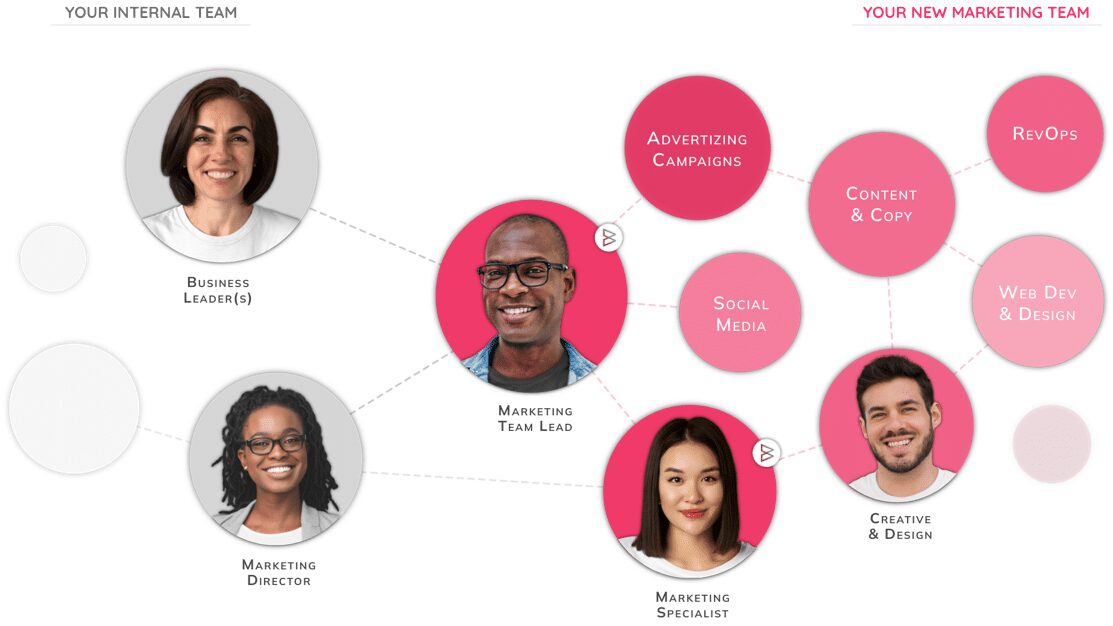Summary (TL;DR)
Insource Marketing is the future. Traditional marketing models—agencies, in-house teams, and contractor clusters—are failing to keep up. Insource marketing blends the dedication of an in-house team with the flexibility and cost-efficiency of fractional talent.
The article breaks down why old marketing structures are outdated, why AI alone isn’t the answer, and how synergy, immersion, leverage, and value (SILVer) create a powerful framework for success. If you’re looking for a marketing solution that delivers real ROI—without sacrificing quality—at a fraction of the cost, this is the must-read guide for you. 🚀
The Insource Marketing Manifesto
Published in 1983 by David Ogilvy, the “Father of Advertising,” Ogilvy on Advertising is one of the most influential marketing and advertising books ever written. A copy of the book has been sitting in the corner of my desk for several years—the cover faded over four decades, but the principles remain fresh. The ideas of Madison Avenue marketers of yore (like David Ogilvy) still pervade the industry. However, the long-established model of marketing agencies has become antiquated in the wake of new technology and changing workforce dynamics. For U.S. companies with revenues below the 85th percentile (about $500M), the traditional marketing agency model is The Walking Dead—full of activity but unable to create value consistently and plagued by high client turnover.
The Marketing Problem:
The 1980s were a simpler time for marketing teams. It was more art than science, driven largely by research and creativity. Today, research and creativity barely make up one slice of the pie. Marketing has become the ultimate team sport, comprising dozens of specializations, including strategy and data analytics, search and social, content writing and video, email automation and RevOps, web development and SEO, events and PR. Each discipline, platform, and channel means another person to hire. Each tool means another subscription. What used to require the abilities and overhead of one or two people now requires a full team.
But what about AI? Yes, AI will eventually supplant some marketing skill sets (copywriting, graphic design, web prototyping, branding, video, etc.), but consider the following:
-
- Companies need marketing to deliver value today, not “eventually.”
-
- AI is creating new skill requirements and competitive channels nearly as fast as it’s displacing them, and this trend is likely to continue for a long time.
No Good Options:
Given the broad talent mix required to execute a successful marketing strategy, companies need a team—augmented but not replaced by AI. There’s no such thing as a Swiss Army knife marketer. The industry is moving too fast for one person to be great at everything, and there isn’t enough time in a single day anyway. This leaves companies with three primary options to assemble a marketing team:
1. Contractor Cluster_____
Most small businesses have tried to make the contractor model work. For startups, this usually means one of the executives has to carve out considerable time to coordinate and manage various contractors. Inevitably, marketing becomes de-prioritized due to sales and operational demands. As companies grow, they hire a marketing leader—only to discover that this leader needs additional resources and budget, which financial constraints often prevent. The result? Marketing leaders “roll up their sleeves,” cobble together a team of fractional contractors, and make technology compromises. While this approach checks the “cost” box, it fails to deliver the synergy required for successful marketing (more on that below). Simply put, a disjointed team of contractors will not produce good results or revenue.
2. (In)House Money
Hiring all or most of your marketing team in-house (assuming competence) is likely to produce a good “top-line” result, but ROI is usually a problem. You might generate twice as many leads compared to option #1, but at four times the cost. Marketing must be driven by value—end benefit divided by cost. If your marketing burn rate is too high, it becomes difficult to produce enough revenue to achieve a positive ROI.
3. The Vendor’ing Machine (Agencies)
Companies turn to marketing agencies for instant expertise and labor. Skilled agency partners can provide direction and execute campaigns efficiently, backed by a team of fractional specialists. However, most agencies still operate like it’s 1980, leading to two major shortcomings: cost and immersion.
-
- High Cost: Working with a marketing agency often feels like a trip to the mechanic—you go in for a specific service and leave with a bunch of additional charges. Need a graphic revised? “That’ll be $300, thanks.”
-
- Low Immersion: Your account is one of ten managed by the same person, who has neither the time nor interest to truly invest in your story, product, or customer.
Door Number 4: Insource Marketing
But what is it?
Insource marketing sits at the intersection of in-house and outsourced models where your dedicated marketing team isn’t on your payroll, yet they operate and feel like your employees. This model delivers excellent marketing results at a fraction of the cost. This is the Van Bram approach.

The 4 Pillars of Insource Marketing (SILVer)
1. Synergy
Marketing is a team sport, not just because there are multiple players, but because those players need to be in sync. Great marketing teams produce results that exceed the sum of their collective skills—the whole is greater than the individual parts. Contractors and agencies struggle to deliver this level of integration.
2. Immersion
Marketing agencies and contractors have long operated at arm’s length, sending performance reports as needed while using their own preferred technology. The future of marketing lies in full integration, where partner teams feel like internal employees, working within the same tools and platforms as the rest of the organization.
3. Leverage
Successful marketing teams must capitalize on force multipliers. Many dominant marketing tools and channels today didn’t even exist a decade ago. Generative AI tools like ChatGPT and Midjourney were released within the past three years. Meanwhile, marketing tech stacks have grown so complex that entire RevOps firms now specialize in managing them. High-performance marketing teams of the future will adeptly use AI, automation, batching, and other efficiency-boosting mechanisms to drive new business while minimizing labor costs.
4. Value
Marketing activities and skill sets are evolving faster than AI and automation can replace them. Each new discipline requires another hire. Each new tool incurs another fee. Each new channel adds another budget line item. The cost of doing marketing is only increasing, and traditional models are failing to keep up. Insource marketing lowers the cost threshold while maintaining synergy, immersion, and leverage.
Implementation…
The 4 pillars are the WHAT, Execution and Results are the HOW. Even the most skilled “insourced” team will struggle without good execution—a frequent point of entropy without constant attention. Finally, a focus on measurable results and performance is essential to optimizing toward ROI.
The Secret Sauce of Insource Marketing
The short answer? Duel-shore teams based in strategic locations.
Marketing and software development are both skilled services, yet marketing has been slower to integrate overseas talent due to two main reasons (aside from the now-simplified process of sourcing talent through platforms like Upwork):
- Agencies prioritize image over efficiency. Urban office spaces, ping-pong tables, semi-frosted glass doors, and expensive benefits create a great vibe—but also inflate client costs.
- U.S. marketing is heavily dependent on native English proficiency. You can write Python code without strong English skills, but marketing is all about words. The key is finding native speakers who blend seamlessly with same-time-zone directors at a lower cost.
Van Bram does more while charging less because we:
- Immerse our marketing directors within your team.
- Empower them with skilled specialists both domestically and abroad—primarily in South Africa.
Why South Africa? Because it’s the most cost-effective place in the world to find native English speakers. That advantage allows us to deliver synergy, immersion, and leverage at an exceptional value—helping our clients drive more business and increase profit.
Now you know what’s behind the curtain at Van Bram.



